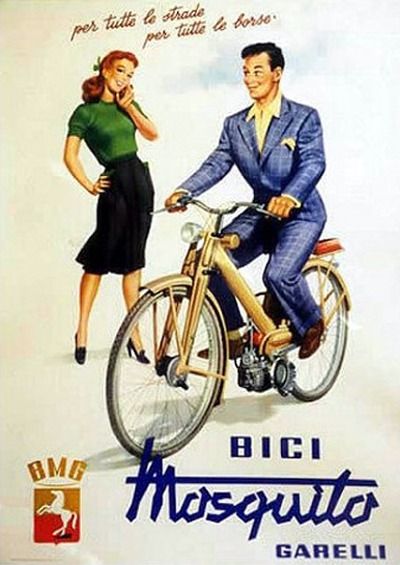GARELLI Mosquito Cyclemotor: The Iconic Engine that Powered Post-War Mobility
The GARELLI Mosquito cyclemotor was a compact, affordable engine that could be attached to bicycles, revolutionizing personal mobility in post-war Europe. Introduced in 1946, the Mosquito engine was simple and effective, converting bicycles into motorized vehicles. It gained immense popularity and was produced under license in various European nations. The success of the Mosquito engines led to the evolution of complete cyclemotors, solidifying GARELLI's reputation as a catalyst for innovation in personal transport. Today, surviving Mosquito models are treasured by vintage collectors and enthusiasts. The Mosquito engine not only had a practical impact on transportation but also played a crucial role in the social and economic resurgence of post-war Europe.
CYCLEMOTORSITALY TWO STROKE1940'SGARELLI
12/20/20233 min read


GARELLI Mosquito Cyclemotor: The Iconic Engine that Powered Post-War Mobility
Introduction
As the cinders of World War II settled, a new era of personal mobility began to rise, led by the introduction of compact, affordable engines that could be attached to bicycles. At the forefront of this revolution was the GARELLI Mosquito. An engineering marvel of its time, the Mosquito was a symbol of freedom and independence, enabling a generation to zip through the ravaged streets of post-war Europe. This comprehensive retrospective pays homage to the ingenuity of the GARELLI Mosquito cyclemotor and celebrates its indelible mark on motorized transportation.
The Genesis of GARELLI Mosquito
The genesis of the GARELLI Mosquito cyclemotor lies in the innovative spirit of Adalberto Garelli, an esteemed engineer who dedicated his career to the advancement of motorcycle technology. In the aftermath of World War II, there was a pressing need for affordable transportation, and Garelli responded to this demand by developing a simple yet effective solution: a clip-on engine for bicycles named the Mosquito. Introduced in 1946, this friction drive engine was a testament to Garelli's prowess, seamlessly transforming everyday bicycles into motorized vehicles that would become essential to Europe's post-war reconstruction.
Design and Mechanics of the Mosquito Engine
The Mosquito engine was the heart of a revolution in two-wheeled transport, characterized by its simplicity and effectiveness. Its innovative friction drive roll system allowed for swift installation onto the rear wheel of a standard bicycle, essentially converting it into a motorbike. The engine came in various iterations, ranging from 38cc to 49cc, all two-stroke models, renowned for their reliability and ease of repair. These small engines were marvels of engineering: compact, lightweight, and remarkably efficient for the technology of the time, affording users an unprecedented level of autonomy in their daily commutes.
Global Impact and Licensing
From the streets of Italy to the boulevards of Paris, the GARELLI Mosquito stretched its wings far beyond its home country. The cyclemotor's immense popularity led to its production under license in various European nations, including France, Spain, and England, a testament to its universal appeal and adaptable design. Local manufacturers embraced the Mosquito, tuning it to fit their nation's needs, yet its core efficiency and practicality remained unchanged. This cross-border success story not only showcases GARELLI's engineering excellence but also demonstrates the Mosquito's vital role in mobilizing post-war Europe, contributing to the continent's economic revival.
Cyclemotors and the Evolution into Complete Bikes
The initial success of the GARELLI Mosquito engines led to an inevitable expansion within the world of two-wheeled transport. As the needs of the population evolved, so did the applications of the Mosquito's technology. Manufacturers began to integrate the engines into purpose-built frames, leading to the birth of complete cyclemotors. These bikes offered more stability and reliability than the clip-on predecessors, cementing the transition from auxiliary engine to fully integrated motorbike. GARELLI's leadership in this transformation solidified its reputation as a catalyst for innovation in personal transport.
Legacy and Collectability
GARELLI Mosquito engines, with their easily recognizable whir and hum, have become coveted items for vintage collectors and enthusiasts of classic motorbikes. Their legacy is cemented in the remarkable tales of endurance, including the record-setting continuous run of a Mosquito engine for over 55 days and nights. Such feats of durability underpin the engine's place in history, not just as a mode of transport, but as a testament to mid-century engineering prowess. Surviving Mosquito models are treasured not only for their functionality but for the stories they carry and their representation of a bygone era.
The Cultural and Practical Influence
The GARELLI Mosquito engine extended far beyond just being a transportation tool; it wove itself into the cultural fabric of post-war Europe. For many, it offered a newfound sense of liberation and an economical way to rebuild lives disrupted by the war. The Mosquito enabled workers to commute to their jobs, empowered small businesses to offer deliveries, and gave young people a taste of newfound freedom. Its impact was both practical and profound, touching on every aspect of daily life and playing a crucial role in the social and economic resurgence of the era.
